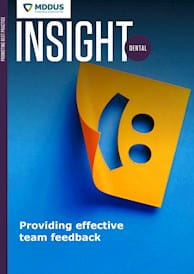PATIENT safety relies on the flow of honest and open feedback – by all team members, across all healthcare organisations. Most people would agree it’s a crucially important component of continuous improvement and risk reduction, but more often than not feedback is something that provokes anxiety in both parties.
It’s worth noting that to support patient safety, regular feedback should be routine and should include both constructive feedback – which we will focus on below – and authentic, meaningful praise.
All too often negative feedback is given in the wrong way or at the wrong time, leading to the individual receiving feedback feeling confused, defensive or upset.
Here are my top 10 questions for you to consider. The answers to these will give you a starting point for approaching feedback interactions to help make them more constructive and comfortable for both you and the receiver.
1. What is the evidence?
Effective feedback relies on tangible evidence or observations. Whether it is quantitative or qualitative, it needs to accurately illustrate the issue at hand. Subjective evidence sets you up for your colleague to debate the validity of your feedback.
2. Is the feedback fair?
To build trust through feedback interactions you should consider whether you are making a reasonable comparison with others who are doing a similar role under similar circumstances. Sometimes, we can be more critical of those colleagues with whom we have a lower quality of relationship and ‘let things go’ too easily with colleagues with whom we feel a greater rapport. This can diminish the power of your feedback, as the individual receiving it can feel picked on, and may focus on that rather than rectifying the issue.
3. Have they been set up to fail?
Organisational and team factors can impact performance and behaviour. These can include an unusually or unacceptably high level of demand on their time, a lack of support including at induction and training, ineffective or dysfunctional team working, an inadequate infrastructure around them, or poor systems and processes. Did you provide training for the person to obtain the knowledge, skills and resources needed to do the job? If you are in a position of influence, it is important to recognise the impact these factors can have on individual performance and behaviour, and recognise/address them as part of any improvement process.
4. Are expectations about standards clear?
Is the performance or behavioural standard you are asking the individual to meet known and understood? Where standards of performance or behaviour are unclear, your feedback is likely to be a surprise and open to challenge. There will be areas where lines are obvious – clinically and professionally. When standards are not agreed, or in grey zones, it may be that your own expectations could be challenged as unreasonable or unachievable.
5. Is a feedback culture in place?
If feedback is already happening day-to-day, including positive feedback and appreciation, then it’s likely your job will be easier. The likelihood is that any feedback won’t be a surprise. If feedback is not routine, even more care should be taken to plan your approach so that the encounter can be a positive one which will build trust and create a positive platform for future feedback interactions.
6. How has the individual responded to feedback in the past?
Considering this can help you approach the feedback encounter in a way that’s more likely to be successful. For example, if the person has previously become defensive, embarrassed or upset, these responses can help you shape the way you word your feedback. This may be less useful if feedback has not been exchanged with that person regularly, and it would be important to consider whether anything has changed since the last encounter. The language you use to share the feedback is important. Clarity and directness are often key.
7. When, where and via which channel should the feedback be provided?
- When. Feedback is often best delivered in person. In terms of timing, it’s likely that, unless the issue is high risk or could have immediate consequences, you can take time to pause to consider these questions before initiating a feedback encounter. If the person is feeling vulnerable and emotional after an incident, it’s best to wait a bit. In these circumstances it might be appropriate to adopt a warm, reassuring style, whilst placing a gentle flag that it will be important to discuss it as a learning experience later on.
- Where. Consider the nature of the feedback to be provided. Do you need privacy? Is there a space you can use where you won’t be interrupted? How sensitive is the issue? Is the person likely to become emotional, and will they need time to process with you? Consider also whether others need to hear the feedback too, but be sure to weigh up the pros and cons of providing feedback in shared areas. Interestingly, you might imagine that praise is always best delivered in person, and perhaps even in public. But keep in mind that some colleagues may not feel comfortable being ‘singled out’.
- Channel. When deciding how to deliver feedback (verbally, email etc), it’s helpful to have an idea of each individual’s preferences. Some people are more comfortable chatting things through, while others prefer an email in the first instance that allows them time to reflect and formulate an action plan to improve. Not all feedback scenarios can/should be addressed ‘offline’ but getting to know your team members’ preferences can make the process more comfortable.
8. Are required actions/changes within the individual’s control?
Will the person need training, coaching or mentoring to make the changes required? If there are dependencies on others it will be important to discuss the desired result and the nature of support required with those involved and ensure you monitor whether these requirements are met to support improvement.
9. How will you respond if the feedback is challenged?
Once you’ve considered the areas above, you should be confident your feedback is reasonable and valid. But no matter how considered the feedback is, everyone will respond differently, so be prepared to counter-challenge appropriately. Some people need time to process feedback before accepting it, while others need to discuss with colleagues to make sense of it. You may need to allow them some time to think before reconvening to agree a way forward. The individual should be encouraged to articulate any points of disagreement regarding the feedback. Focus on understanding any points of difference – if you can’t agree what the issue is, and how it should be resolved, it is unlikely that the required change or outcome will be achieved.
10. How will you review whether feedback is effective?
Sometimes feedback will come as a surprise and the person involved will need time to think. The nature of the change required may be complex, the individual may need further training, or it may involve a change in behaviour. Whatever the circumstances, it is likely you will need to allow some time to reflect and to agree the changes required to meet your expectations. You should then diarise to follow up with the person within an agreed timescale. In some cases, you may need to provide regular feedback on gradual improvements in performance or behaviour to keep the person on track until they meet the agreed standards.
By answering these 10 questions, you should be able to deliver vital feedback to your team by having more constructive and comfortable feedback encounters.
Sign up to this MDDUS course to learn more
We have tickets available throughout the year for our course Building a feedback culture to reduce risk:
This page was correct at the time of publication. Any guidance is intended as general guidance for members only. If you are a member and need specific advice relating to your own circumstances, please contact one of our advisers.
Read more from this issue of Insight Dental





